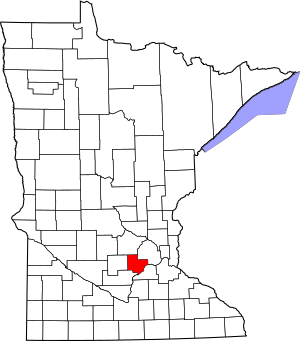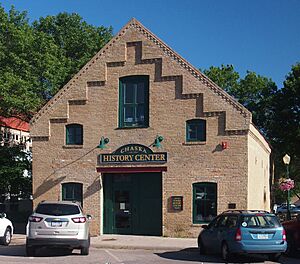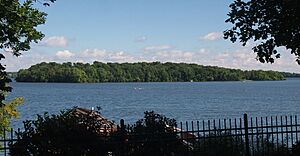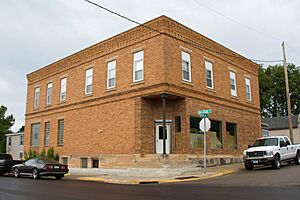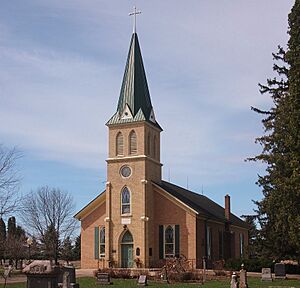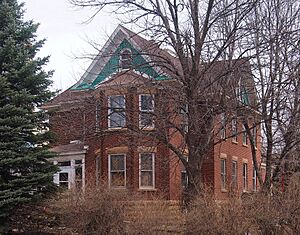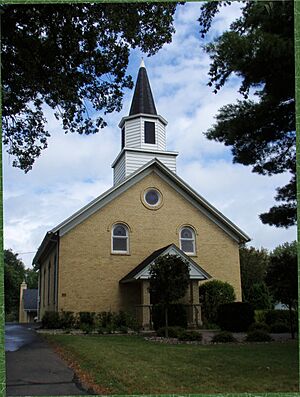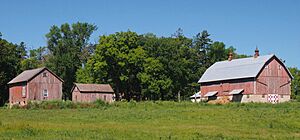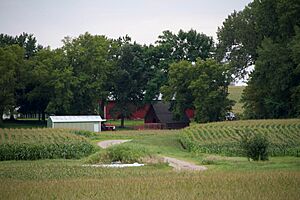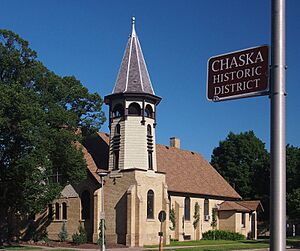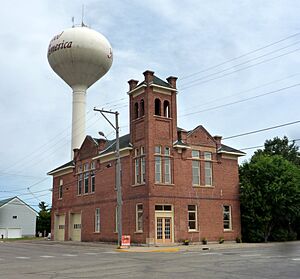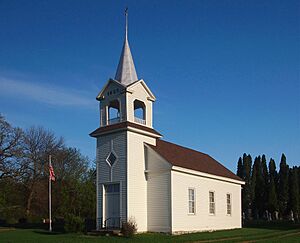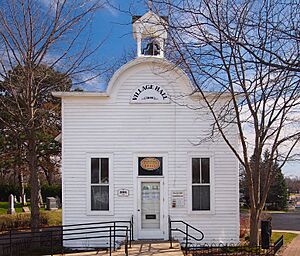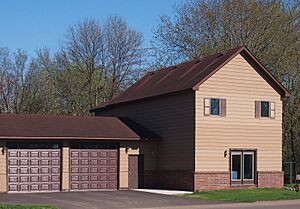National Register of Historic Places listings in Carver County, Minnesota facts for kids
Carver County, Minnesota, is home to many special places that are listed on the National Register of Historic Places. This is a list of buildings, areas, and sites that are important to the history of the United States. They are officially recognized and protected because they tell us about the past.
There are 34 places in Carver County on this list. Many of these buildings are made from a unique local material called Chaska brick. This brick has a special cream color. You can see where these historic places are on an online map.
Contents
- Historic Places in Carver County
- Emile Amblard Guest House
- Brinkhaus Saloon Livery Barn
- Carver Historic District
- Coney Island of the West
- Wendelin Grimm Farmstead
- Jacob Hebeisen Hardware Store
- King Oscar's Settlement (East Union)
- John Knotz House
- Laketown Moravian Brethren's Church
- Andrew Peterson Farmstead
- Johann Schimmelpfennig Farmstead
- Waconia City Hall
- Walnut Street Historic District (Chaska, Minnesota)
- Young America City Hall
- Zoar Moravian Church
- Former Listings
Historic Places in Carver County
This section highlights some of the cool and important places in Carver County that are on the National Register of Historic Places. Each one has a unique story to tell!
Emile Amblard Guest House
The Emile Amblard Guest House is a lodging house built around 1900 in Waconia. It is the best-preserved building from Waconia's early resort days. This house was designed by Emile Amblard, who helped create the famous Coney Island of the West resort.
Brinkhaus Saloon Livery Barn
In Chaska, you can find the Brinkhaus Saloon Livery Barn. It was built around 1875 and was a stable for horses that belonged to a saloon. It's a rare and well-preserved example of early businesses in Chaska. Today, it is home to the Chaska Historical Society.
Carver Historic District
The Carver Historic District in Carver is a well-preserved part of an old town along the Minnesota River. It has about 100 buildings, mostly built between 1855 and 1880. This district has the most historically and architecturally important buildings in Carver County.
Coney Island of the West
Imagine an old amusement park on an island! Coney Island of the West was located on Lake Waconia and was one of Minnesota's most popular resorts. From the 1880s to the 1920s, people came here to enjoy hotels, cottages, and parks. Today, you can still see the ruins of these old buildings.
Wendelin Grimm Farmstead
The Wendelin Grimm Farmstead is a 160-acre farm near Victoria. It includes an 1876 house. A German immigrant named Wendelin Grimm developed the first type of alfalfa here that could survive cold North American winters. This was a huge step for farming! Today, it's an educational facility.
Jacob Hebeisen Hardware Store
In Hamburg, the Jacob Hebeisen Hardware Store was built in 1907. This building is important because the hardware store became a consumer cooperative in 1919. This was a big movement in Minnesota that helped farmers and businesses work together.
King Oscar's Settlement (East Union)
Near Carver, you'll find King Oscar's Settlement, also known as East Union. This is a well-preserved group of religious buildings from Carver County's first Swedish American community. It includes an 1865 caretaker's cottage, an 1866 church, and an 1874 parsonage. This settlement also played a role in the founding of Gustavus Adolphus College.
John Knotz House
The John Knotz House in Cologne was built in 1905. It belonged to John Knotz, a doctor who worked for the railroads. His wife, Rosa Partoll Knotz, was an early supporter of women's rights. She even served as Cologne's mayor three times in the 1920s!
Laketown Moravian Brethren's Church
The Laketown Moravian Brethren's Church, built in 1878 near Victoria, is a great example of a rural church building. It shows how church designs changed over time in Carver County, from simple wooden buildings to more detailed brick ones.
Andrew Peterson Farmstead
Northeast of Waconia is the Andrew Peterson Farmstead. It has five buildings connected to Andrew Peterson, a Swedish immigrant. His diary, which he kept for 43 years, later inspired the famous The Emigrants novels by author Vilhelm Moberg.
Johann Schimmelpfennig Farmstead
Near Norwood Young America, the Johann Schimmelpfennig Farmstead shows how farms in Carver County grew over time. It has three log buildings from 1856, when farmers grew just enough food to survive. An expansion in the 1870s shows growing wealth, and a 1909 barn shows a shift to raising livestock and dairy farming.
Waconia City Hall
The Waconia City Hall, built in 1909, was a very important building for the town of Waconia. It housed the city government, fire department, library, and meeting hall. It was a central place for community activities and has unique architecture for the area.
Walnut Street Historic District (Chaska, Minnesota)
The Walnut Street Historic District in Chaska has many well-preserved buildings. These range from old Native American burial mounds to commercial, industrial, residential, and religious buildings. They show Chaska's history from ancient times up to 1920.
Young America City Hall
The Young America City Hall, built in 1909, is one of the best examples of early government buildings in Carver County. It was a major landmark in Young America and housed the city government for a long time. Today, it is a private home.
Zoar Moravian Church
The Zoar Moravian Church, built in 1863 near Waconia, is still mostly in its original condition. It is the only surviving example of three churches built by the early Moravian Church followers in Carver County.
Former Listings
Some places that were once on the National Register of Historic Places in Carver County are no longer listed. This can happen if a building is moved, changed too much, or torn down.
Chanhassen Township Hall
The Chanhassen Township Hall was built in 1890 in Chanhassen. It was a municipal hall, meaning it was used for local government. It was delisted in 1990 after it was moved in 1988.
Iltis Brewery and Ice House
The Iltis Brewery and Ice House in Chaska were buildings from a brewery that started in 1866. They were important as the last remaining example of Chaska's early brewing industry. Sadly, they fell apart and were torn down in 1989, so they were delisted.
Kusske and Hahn Saloon
The Kusske and Hahn Saloon was an 1870 building in Mayer. It was delisted in 2001 because it was changed significantly.


